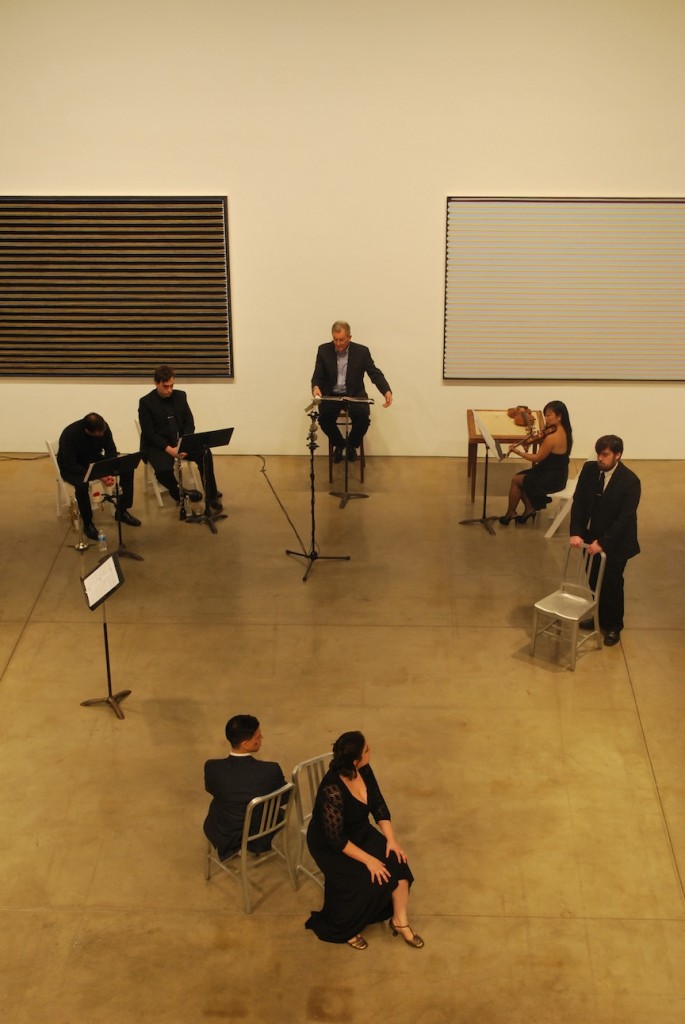Kotik opera creates compelling character study from Stein texts

Petr Kotik’s opera “Master-Pieces” received its New York premiere Wednesday night at the Paula Cooper Gallery. Photo: George Grella
Petr Kotik—composer, musician, conductor, impresario—has made a specialty of setting Gertrude Stein’s writing to music, a niche but not a novelty.
What is unusual is not that Kotik creates pieces like Many May Women and his new chamber opera, Master-Pieces, which premiered Wednesday night at the Paula Cooper Gallery—but that so few other composers have set Stein to music.
Stein’s writing, as flat and affectless as it appears on the page or sounds in the ear, is an ideal source for vocal music. Her concise, lapidary way with rhythm solves one of the most difficult challenges in turning prose and verse into song, setting syllables and words across organized and subdivided time. The rest is what composers do with words, deciding what meaning they should convey and writing music to express that.
For Master-Pieces, Kotik has used Stein’s 1936 lecture “What Are Master-pieces And Why Are There So Few of Them,” which is sung and spoken, primarily, by a soprano (Kamala Sankaram), countered and accompanied at times by a trio of male voices (tenor Marty Coyle, baritone Jeffrey Gavett and bass Adrian Rosas). Dividing the lecture into scenes, Kotik has also interspersed the work with sections from “The Wars I Have Seen,” from Stein’s mid–1940s diary. These are spoken by a trio of narrators, who deliver the monologues in counterpoint to each other. On its face, one might think that calling this an opera is just another example of the formal term being applied to any contemporary work that has singing, but Kotik has fashioned a subtle effective but entirely clear dramatic line out of such unlikely material.
The music is full of character, starting with the substantial instrumental prologue—which is not an overture. The performance began with Pauline Kim expertly playing a challenging solo, a continues flow of music that slid back and forth from Bach-like arpeggiations to highly chromatic, expressionistic phrases. After some time, trumpeter Thomas Verchot began playing from the gallery adjacent to the large, barn-like main space. (The S.E.M. Ensemble was rounded out by Jeffrey Reinhardt playing oboe and english horn, and percussionist Chris Nappi.) Verchot’s concise, spacious material at first seemed like a response to the violin, something out of the Symphonie Fantastique.
Instead, though, it was a structural cue: Kim exchanged her violin for a viola, and her music became slow, quiet and mournful. This was a pattern throughout—Kim playing what was a continuo, and exchanging the two instruments and their specific music like masks on a character. The music has a quality that is unique to Kotik’s composing, it is sinuous, hypnotic, perched at the tense edge of monotony. Kotik uses minimal means to create an expansive experience as well as any other composer.
The main character was Sankaram, who is a leading figure on the new opera scene. She has sung Kotik’s work before, and her translucent timbre, exact intonation and precise articulation were ideal for the piece—even though a printed libretto was available with each program, all the singing was so clear that one heard every word.
While the men had music much in the style of Many Many Women—repetitive, tightly confined to a few pitches, resembling plainchant—Kotik’s writing for the soprano is full of shape and color and the sheer sonic pleasure of the voice. Sankaram sounded great, and also had a fine balance of poise in the spoken sections, commanding and confident without, well, lecturing too much. She was also barely flustered by making one entrance singing, briefly, the wrong material.
The combination of Stein and the singer makes for a concrete character in what is a drama about transformation. Discerning what, exactly, the character is transforming into would require more than one experience with this objectified but pellucid musical language. What is clear is that the opera is a story of existential creation, the struggle to shape and define one’s identity.
The narration, performed by Kerry Wolf, Sheila MacDougall and Bernard Feinerman, sets this in relief. The conversational feel of the personal reminiscences is a humanizing voice.
Sankaram’s singing is the voice of a person who takes on the stance of a character, with the lecture as performance, expressing intellectual values while sheltering personal ones. The text, through the satisfyingly grainy sound of the men’s Greek Chorus, elides “master-pieces” as a subject with one’s self as the subject.
Early in the opera, Sankaram sings “Talking has nothing to do with creation,” but ultimately talking, and singing, and the impressions that accumulates through time, is absolutely about creating and defining. Near the end, everyone sings “When you are working you are writing … And you cherish everything that you have ever created.” Like M.C. Escher’s Drawing Hands, Stein and Kotik have come together to create a character from the experience of words and music.



Posted Dec 28, 2014 at 4:35 pm by Lavender Poet
O the glorious sounds of Ms. Stein! I have for years been enraptured by the sound language that she introduced to poetry, and would so love to hear this magnificent piece as well. And you are indeed right: Why haven’t many others captured these sounds and let them resonate throughout the world?